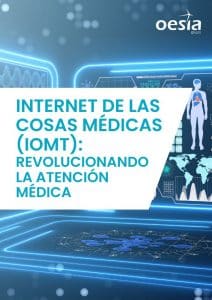
The confluence of technology and medicine in the 21st century has led to a revolution in healthcare. In this context, the Internet of Medical Things (IoMT) emerges as a transformative phenomenon that redefines healthcare and changes the way patients interact with their health. In this in-depth exploration, we will break down the concept of IoMT, its applications in the healthcare sector and the benefits it offers. In addition, we will address the critical challenges that must be overcome to realize its full potential.
IoMT: Demystifying the health revolution
IoMT is the convergence of medical devices and systems through Internet connectivity. From wearable devices that monitor vital signs to advanced hospital medical equipment, the IoMT enables real-time data collection and transmission. This trend is transforming healthcare by providing constant monitoring and seamless communication between patients and healthcare professionals.
IoMT in Action: Transforming Healthcare
Remote and continuous monitoring:
A vital contribution of IoMT is the possibility of continuous and remote patient monitoring. Wearable devices, such as glucose meters and smart watches, allow physicians to access real-time patient data. This facilitates early detection of problems and instant adaptation of treatment plans.
Accurate and personalized diagnosis:
IoMT enables detailed health data collection and analysis. Physicians can use this information to gain a complete picture of patients’ health and make more accurate and tailored diagnoses. This leads to more effective and personalized treatments, improving overall results.
Optimization of hospital resources:
In the hospital environment, IoMT also has a significant impact. Connected medical devices can send automatic alerts when they require maintenance, reducing downtime and improving the efficiency of care. In addition, real-time monitoring of hospitalized patients enables rapid responses to changes in their condition.
Strengthening self-care:
IoMT devices empower patients by providing them with real-time information about their health and habits. Apps and devices that track physical activity, sleep and other health indicators motivate people to take a proactive approach to their well-being. This encourages prevention and a greater commitment to personal health.
Economic benefits of IoMT in healthcare:
IoMT implementation not only has clinical and patient benefits, but can also have a significant impact on the economics of healthcare. This section will explore how IoMT can reduce long-term medical costs by preventing unnecessary hospitalizations, optimizing resource use, and improving the overall efficiency of healthcare systems. In addition, it could be discussed how initial investments in IoMT technology can translate into long-term savings and how this could affect the accessibility and sustainability of healthcare in different contexts.
Key challenges and considerations
Data security and privacy:
With the transfer of sensitive medical data via IoMT, data security is paramount. Protecting patients’ personal information and preventing cyber attacks is essential to ensure trust in this technology.
Interoperability and standards:
The lack of uniform industry standards can make integration and communication between different IoMT devices and systems difficult. Establishing robust interoperability protocols is essential to ensure a consistent experience for patients and healthcare professionals.
Training and adaptation of health professionals:
Effective IoMT adoption requires appropriate training for healthcare professionals. Interpreting and using the data generated by these devices is essential to take full advantage of their benefits in medical practice.
Success story and future prospects
IoMT has proven its effectiveness in a number of use cases. From remote monitoring of chronically ill patients to improving hospital efficiency, these examples highlight the positive impact on modern healthcare.
Looking ahead reveals an exciting picture. The combination of IoMT with artificial intelligence and machine learning has the potential to further revolutionize medical diagnosis and treatment. In addition, the expansion of telemedicine through IoMT can improve access to care in remote areas.
Ethics and final reflections
IoMT raises ethical and privacy questions. The collection and use of personal health data requires a careful approach to ensure the confidentiality and protection of patient information.
While it promises a number of benefits, it also raises ethical and social issues that must be carefully considered. This section could address issues such as the potential digital divide that could leave some groups without access to these advanced technologies, concerns about the loss of privacy in an increasingly connected world, and how healthcare professionals balance the incorporation of technology with human attention and the personal touch in healthcare.
The Future: the connection to health
The Internet of Medical Things is at the center of healthcare transformation. By facilitating monitoring, diagnostics and communication, IoMT offers a range of benefits that are shaping a healthier future. Despite current challenges, its potential to improve patient quality of life and healthcare efficiency is undeniable. Staying informed about this revolution in healthcare is essential to be prepared and take full advantage of the opportunities that IoMT offers in the digital era.
Yulisa Dominguez, Head of Digital Health in Grupo Oesia.
